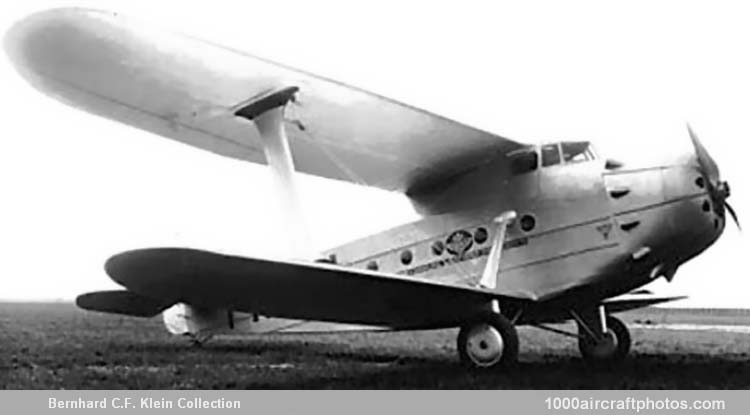It was built in the workshops of the Maatschappij tot vervaardigen van Werktuigen en Spoorwegmateriaal (Society for the manufacture of Machinery and Railway Equipment) "Werkspoor" at Zuilen, the Netherlands, hence the Jumbo, as the aircraft affectionally was named, was also referred to as the Werkspoor Jumbo and Carley-Werkspoor Jumbo.
The Jumbo was of entirely wooden construction. The tapered wings were of unequal span, the upper wing had a span of 62 ft 4 in (19.00 m) and a maximum chord of 9 ft 2.2 in (2.80 m), the lower wing had a span of 56 ft 9.1 in (17.30 m) and a chord of 7 ft 10.5 in (2.40 m).
Interconnected by I-struts, the wings were covered with plywood and fabric. The fuselage had a semi-monocoque structure and was covered with plywood, two cargo doors on the left side gave entrance to the cargo hold that had a volume of 547.38 cu.ft (15.5 cu.m).
The two-seat enclosed cockpit was situated in front of the upper wing and had doors on each side. The only steel used in the aircraft was the tube frame that carried the 480 hp Gnome & Rhône nine-cylinder air-cooled radial engine, driving a two-bladed metal screw. The tail dragger had a fixed landing gear.
Construction was started in 1929, on July 26, 1930, the first trial run took place, and in August the machine was first flown by Izaäk Alphonse 'Fons' Aler, while on November 20, 1930, the sole Carley Jumbo was registered to KLM as PH-AFI.
However, service operations were delayed due to overheating problems, as originally, the engine was almost completely enclosed to reduce drag as much as possible. After much experimenting the aircraft appeared in early 1931 with an open cowling, baffle-plates and cooling vents on each side of the engine.
The career of the Jumbo started on March 12, 1931, and in 1931 and 1932 the freighter was used on the Amsterdam–Rotterdam–London route. Thereafter the aircraft was mainly used as a trainer, particularly for instrument flight training.
The aircraft was not a major success in both cases, as it had rather poor handling characteristics. Several times the aircraft was damaged upon landing, including on May 10, 1933 and August 1937, when it made a nose stand after heavy braking. On February 2, 1940 it was deregistered, and finally was destroyed in the German bombing of Schiphol on May 10, 1940."
Span: 62 ft 4 in (19.00 m)
Length: 44 ft 11.4 in (13.70 m)
Height: 14 ft 3.7 in (4.36 m)
Wing area: 878.55 sq.ft (81.62 sq.m)
Weight empty: 4,912 lb (2,228 kg)
Loaded weight: 8,818 lb (4,000 kg)
Max speed: 114 mph (184 kmh)
Cruise speed: 99 mph (160 kmh)
Landing speed: 47 mph (75 kmh)
Service ceiling: 9,843 ft (3,000 m)
Range: 578 mls (930 km)
